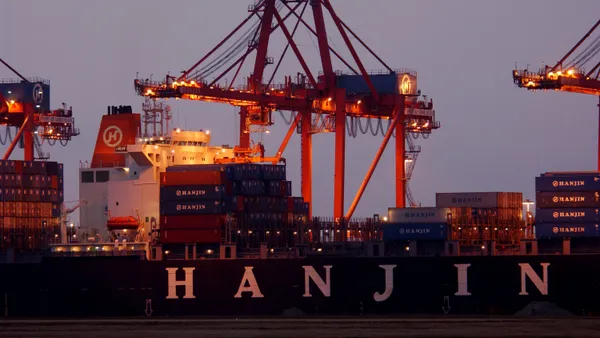OAKLAND, Calif. — After a year of disruptions, the Port of Oakland is focusing its efforts to recapture market share and prepare its facilities for the future, the port’s top executive told industry stakeholders Tuesday.
The landlord organization, which also operates the city’s airport and commercial harbor, manages one of the few seaports in the nation that has seen volumes decline since the pandemic. Although the Port of Oakland remains the ninth largest containerport in the U.S. by volume, it handled 200,000 fewer TEUs in 2022 than it did in 2018, according to data collected by Supply Chain Dive.
But, speaking to a room of colleagues, clients and collaborators gathered for lunch at the annual State of the Port address, Port of Oakland Executive Director Danny Wan pledged to turn the trend around.
“We are working on increasing our market share that we lost during the pandemic,” Wan said. “We've not given up. Not only are we going to recapture that volume, we're going to grow that volume.”
Wan highlighted efforts on two fronts that could help reclaim cargo. In the short term, the port is one of a few organizations piloting a data transparency portal “to make sure people know where their stuff is.” In the long term, the organization is also targeting infrastructure improvement projects that can set the seaport up for greener operations, greater volumes, and smoother cargo flows.
“We anticipate fully that cargo volumes will increase by mid-year as we normalize,” Wan predicted.
In the meantime, the port has a laundry list of infrastructure projects it says are necessary for growth. It’s planning, for example, to eventually reactivate a 120-acre marine terminal that would boost its capacity. It is preparing for a zero-emission future, and applauding terminals who take steps to lower their emissions. And, it’s proposing to upgrade critical roads, pavements and rail crossings it sees as needing modernization.
To achieve infrastructure improvements, Wan said the port is looking to take advantage of the public spotlight on supply chains and aggressively apply for newly available grant funding at the state and federal levels.
“There is for the first time in my memory dedicated money, for both federal and state budgets, for ports,” Wan said, while noting the availability of funds presents a unique opportunity “to change the way we operate.”
Throughout the speech, Wan also took the time to share a few stories of the Port of Oakland’s legacy that highlighted the port’s ability to face crises and respond to opportunities.
The 96-year-old port was, after all, an early driver in the country’s push to handle containerized cargo. And just years ago, at the start of the COVID-19 pandemic, he reminded attendees it was the Port of Oakland that was trusted to safely receive the Grand Princess — a cruise ship that arrived with more than a dozen confirmed COVID-19 cases in early March — and quarantine its passengers.
“I'm proud to say that not only that the state of the port is one of recovery and resilience, but its future is one of continued to growth to continue to port's legacy of innovation and expansion,” Wan said to conclude his speech.
After the speech, Joe Cutrera, director for export marketing at freight forwarder Savino del Bene, told Supply Chain Dive he wished the port had taken and responded to questions from the audience, but was glad to hear of the port was making progress on its green infrastructure ambitions.
“I just hope that they pitch a little bit of the infrastructure to bring back a lot of the vessels and cargo that are going to other ports on the West Coast,” Cutrera said, noting that when volumes return, the port will also need to ensure cargo flow at the gates have improved as well.
Correction: A previous version of this story misspelled Joe Cutrera’s last name.















